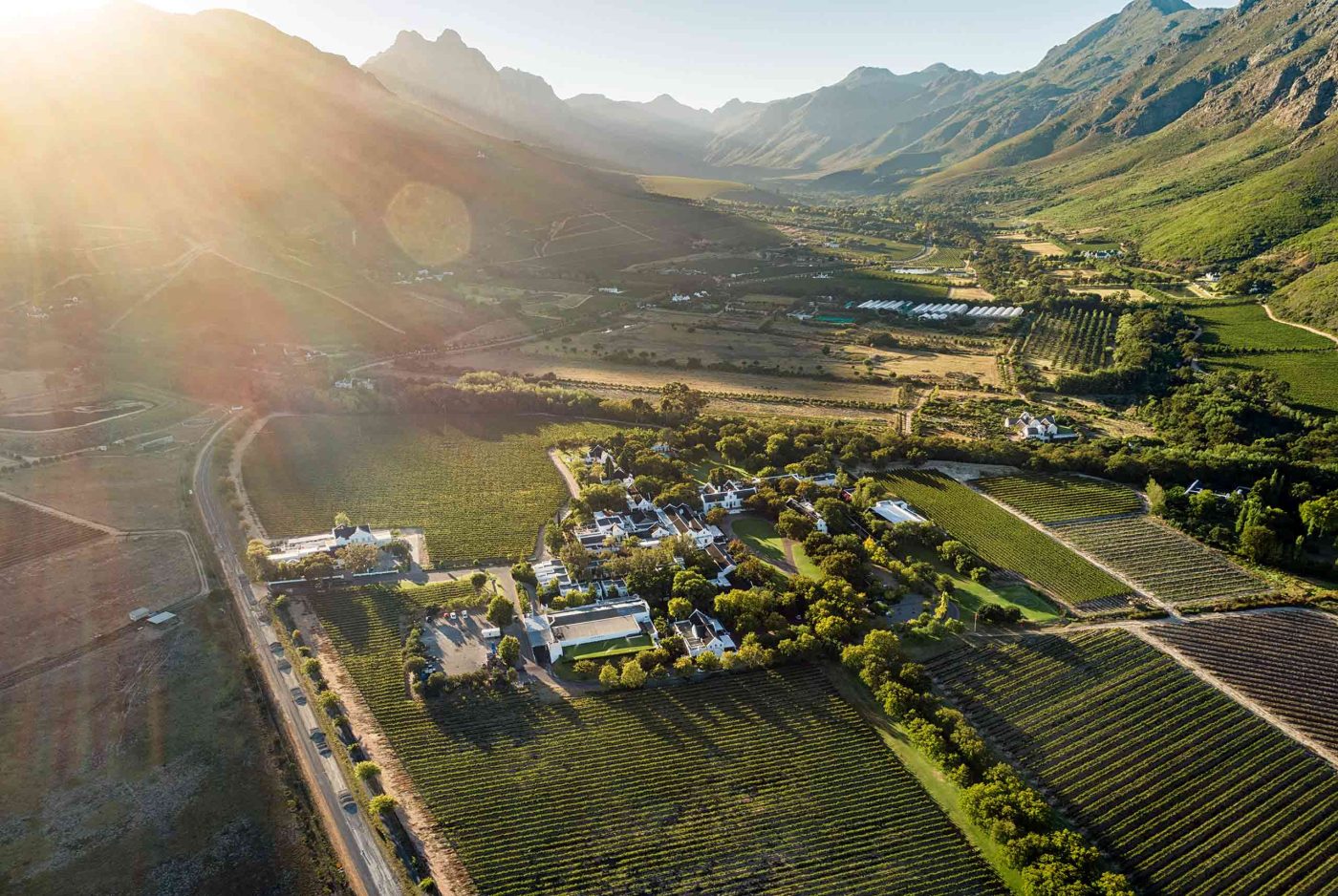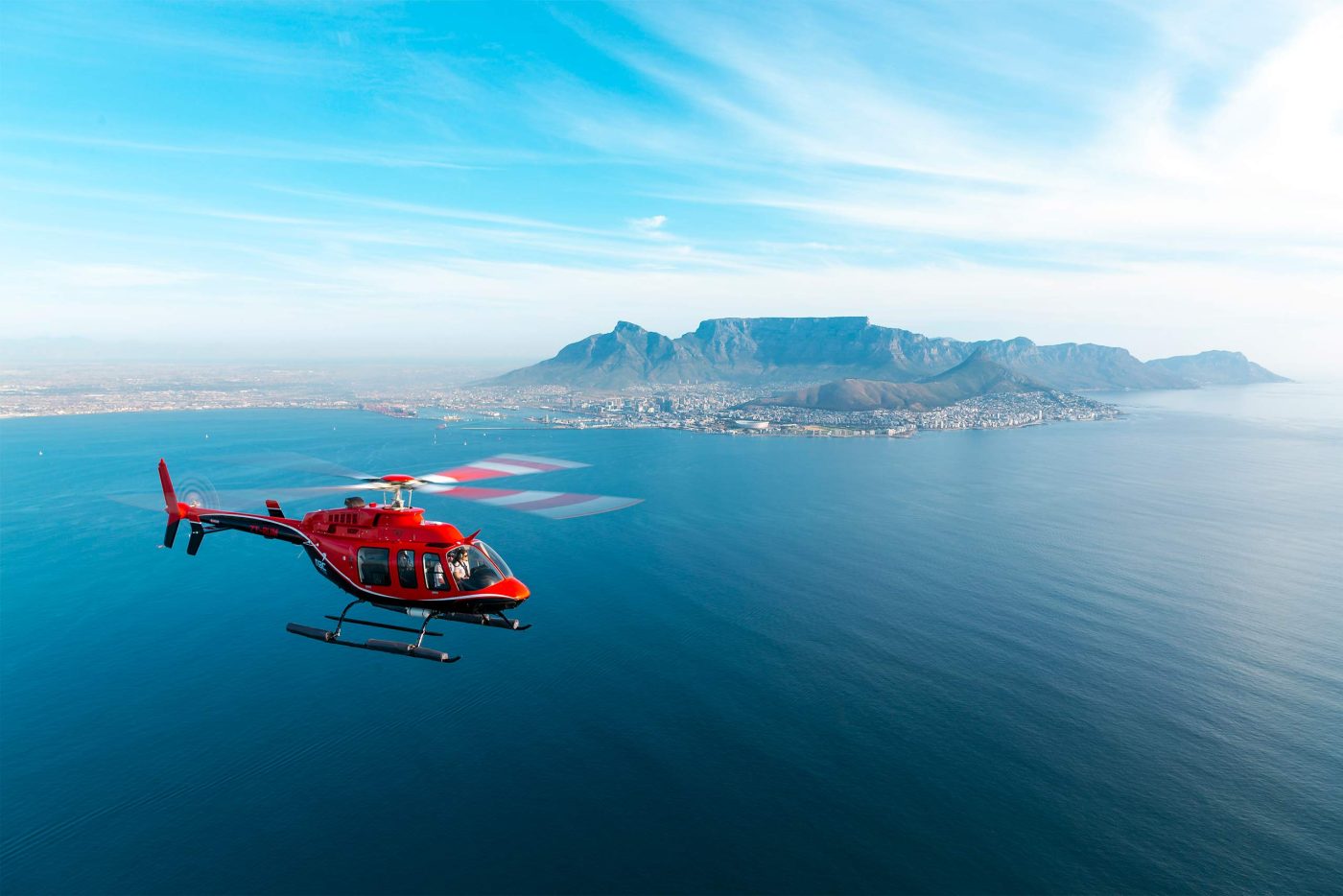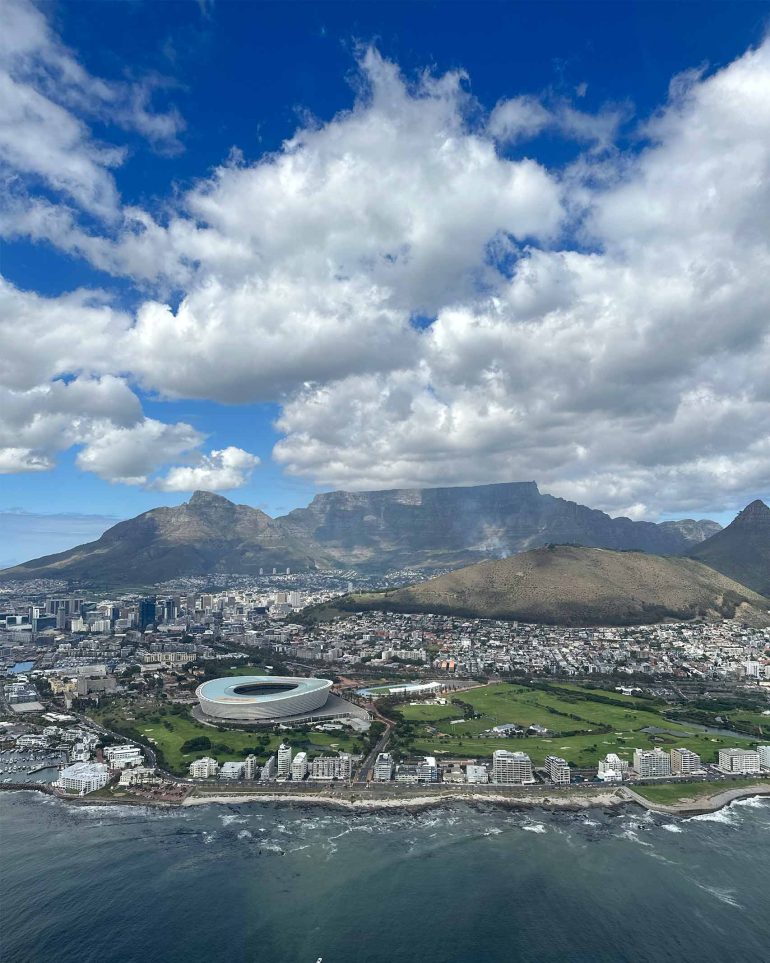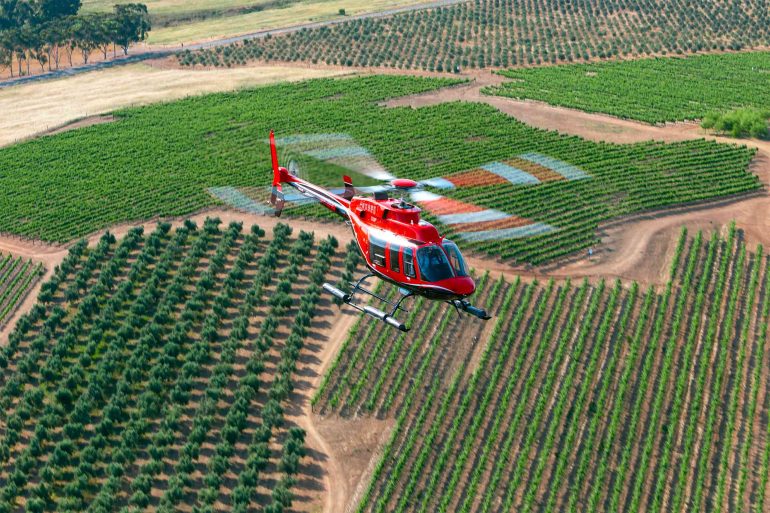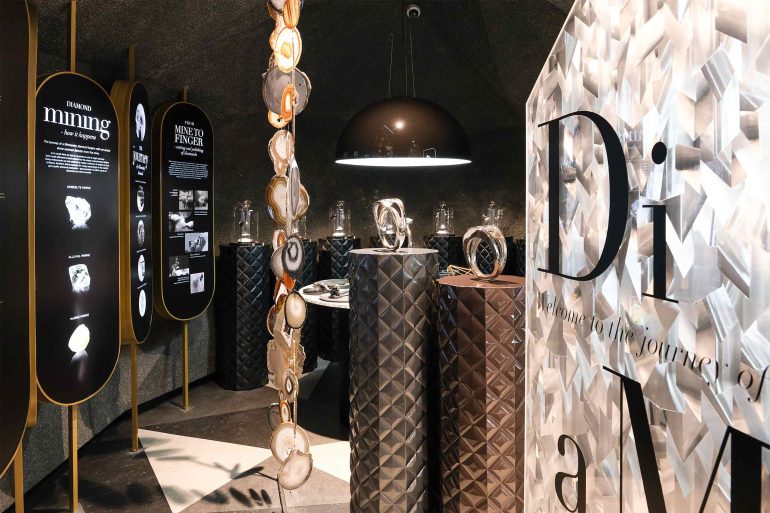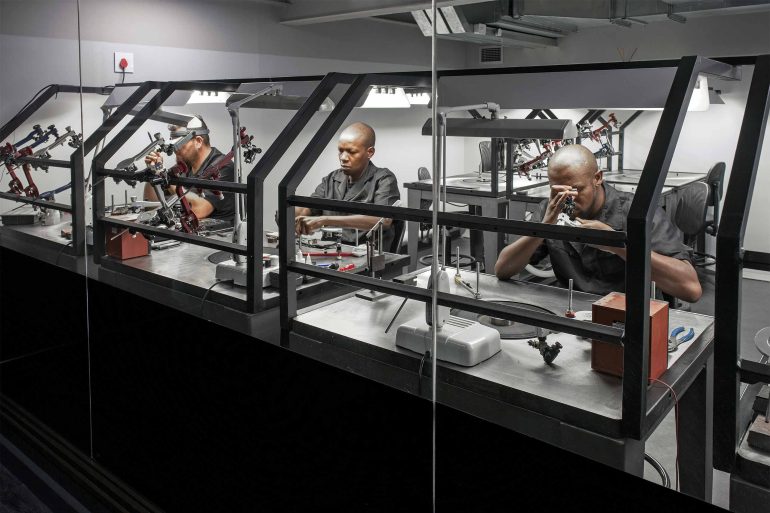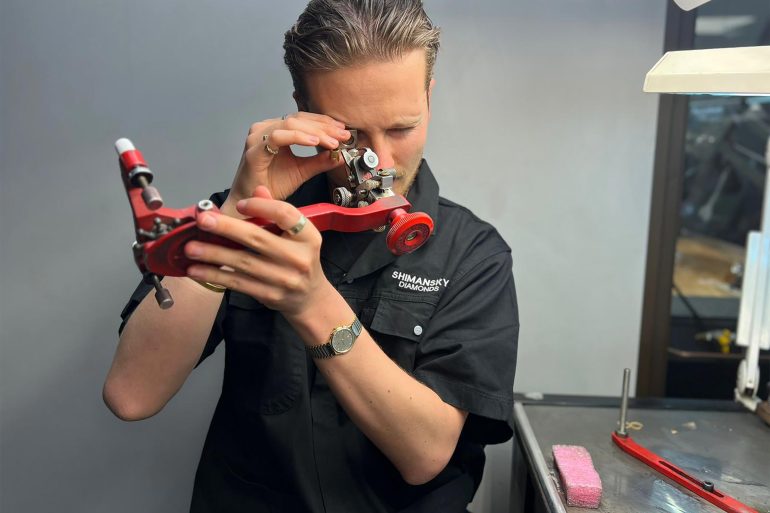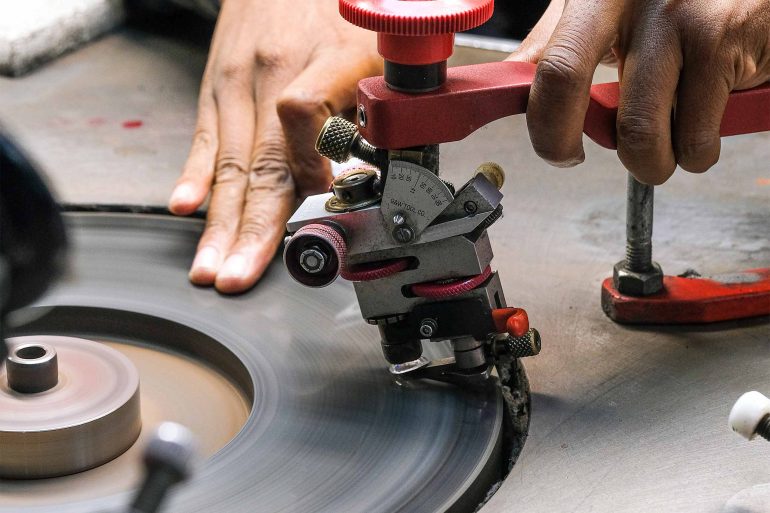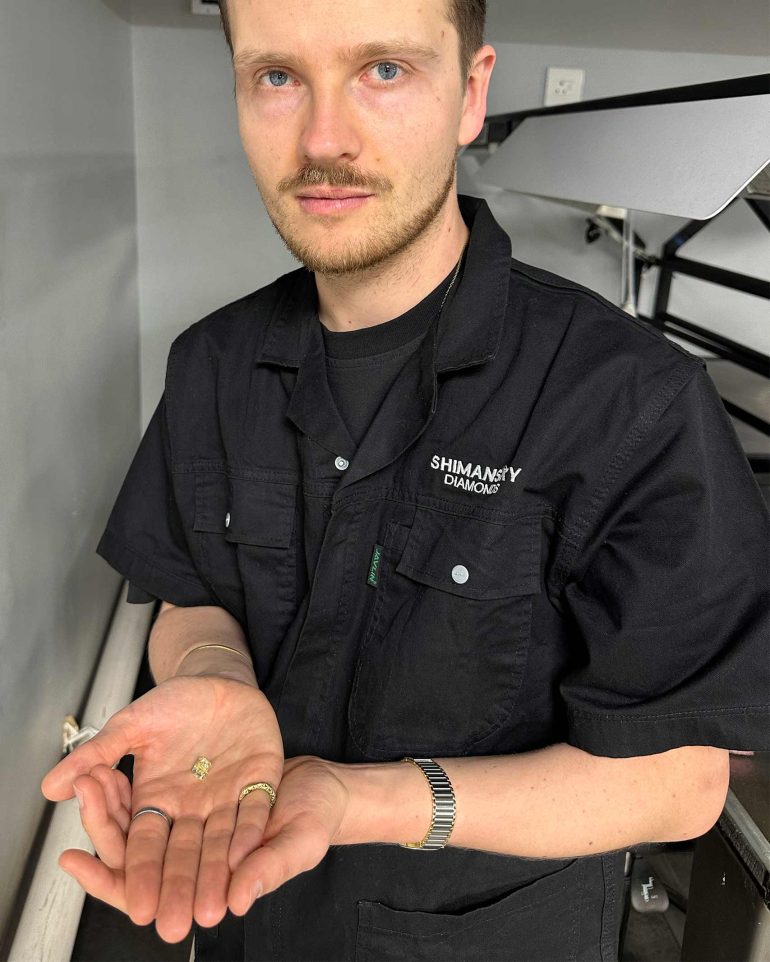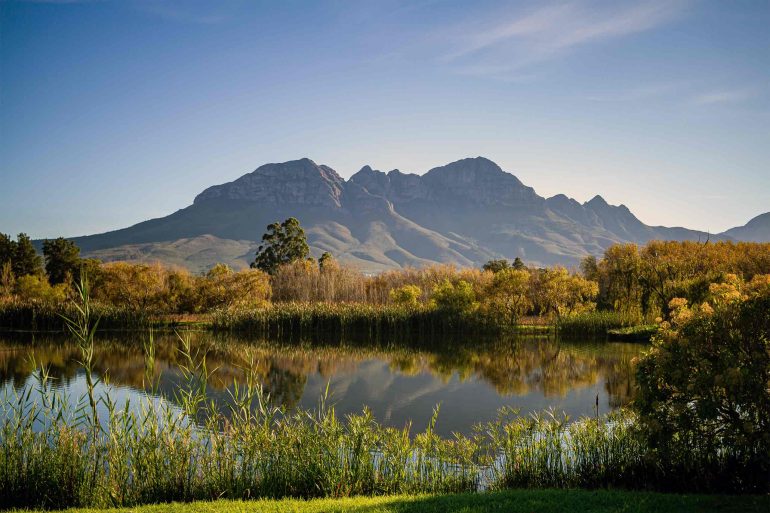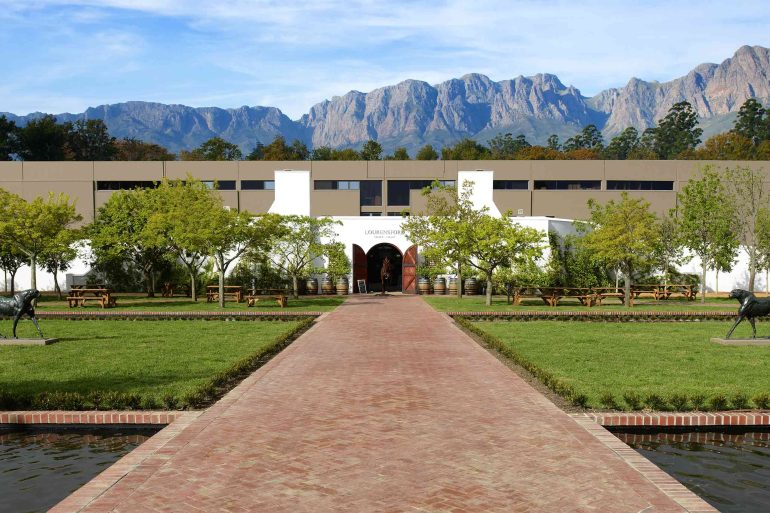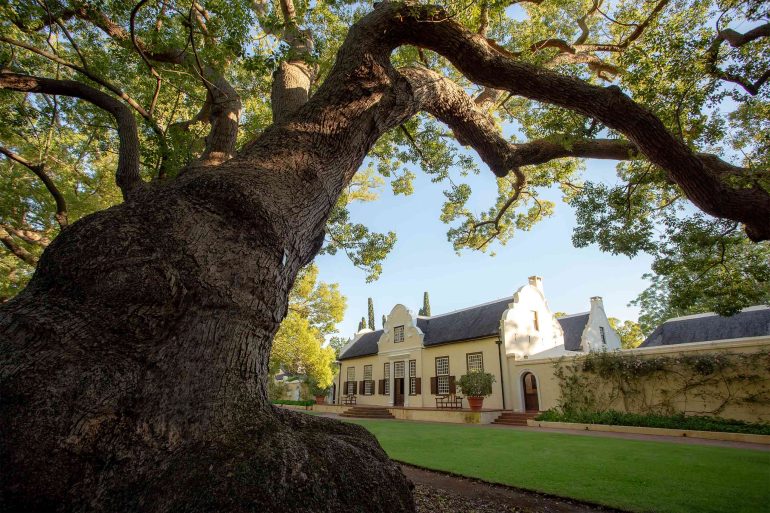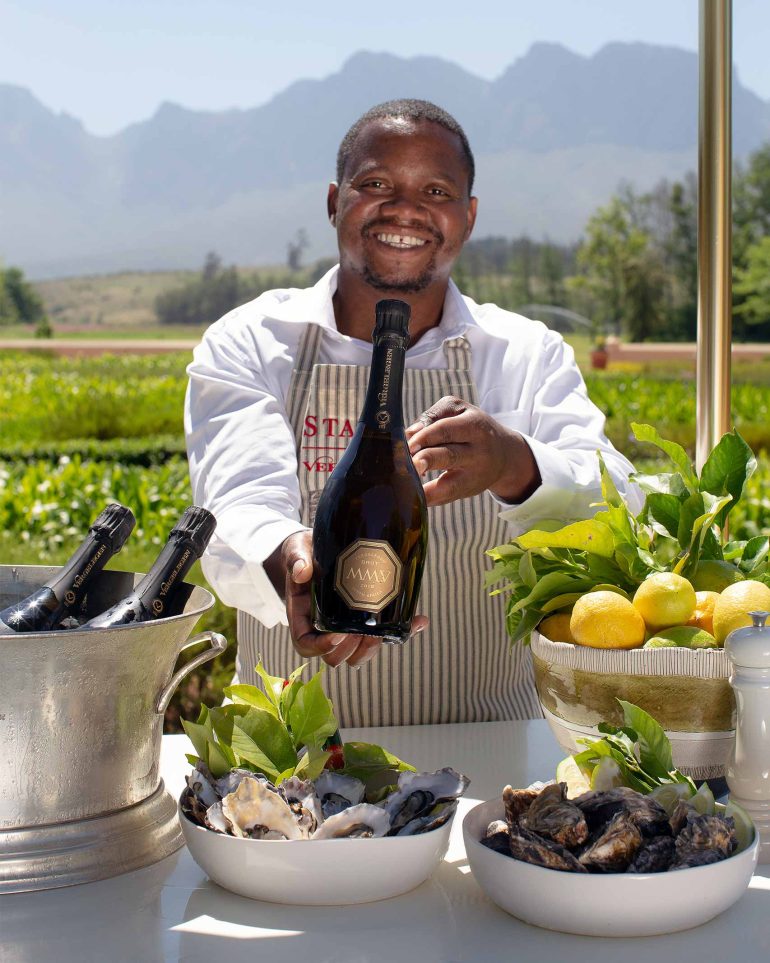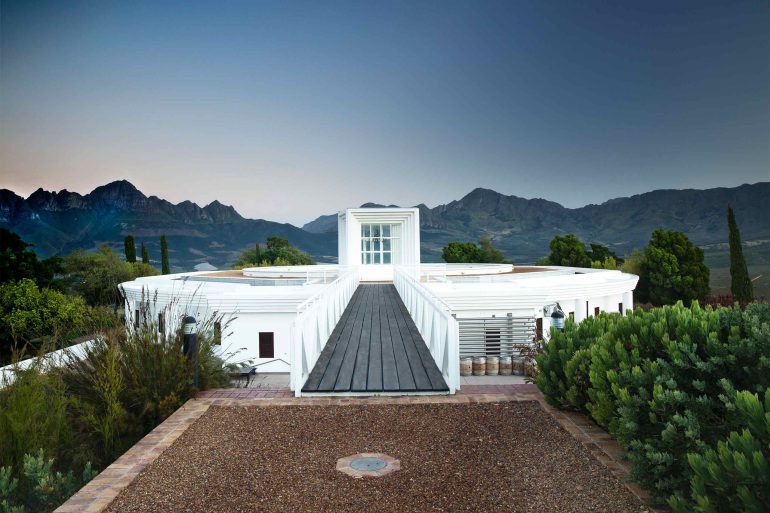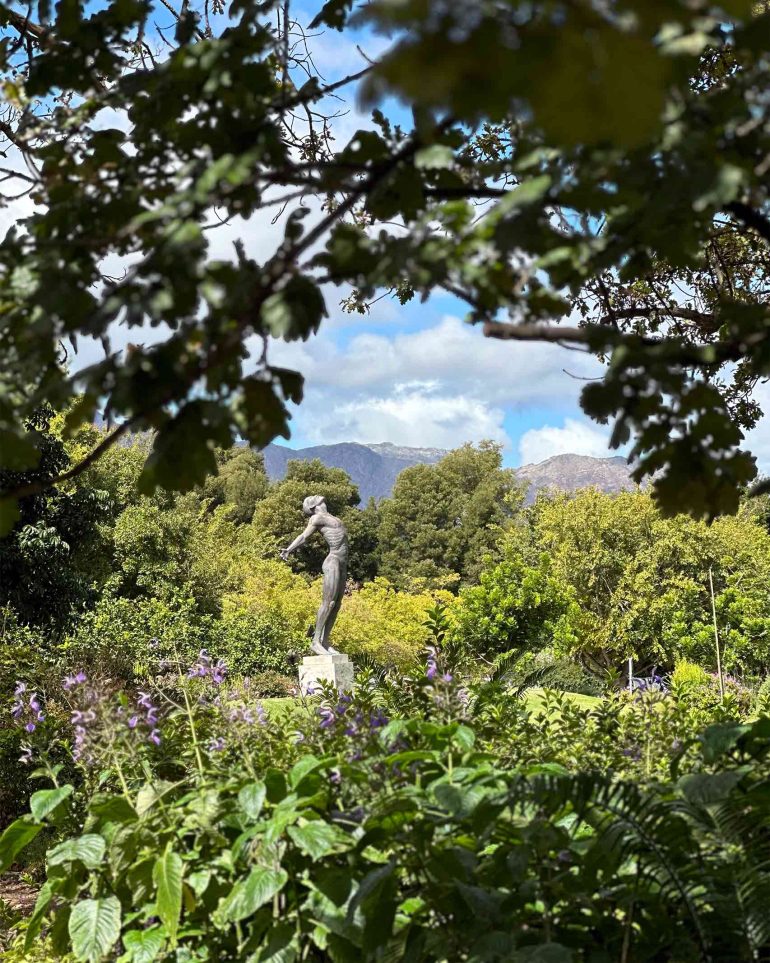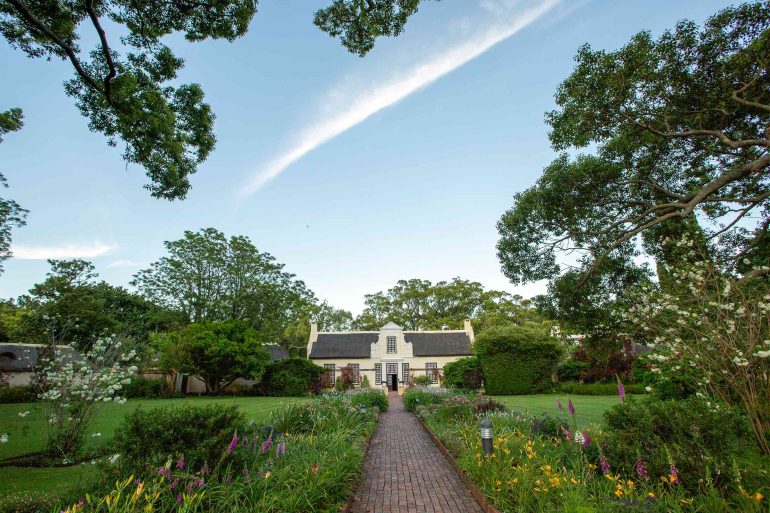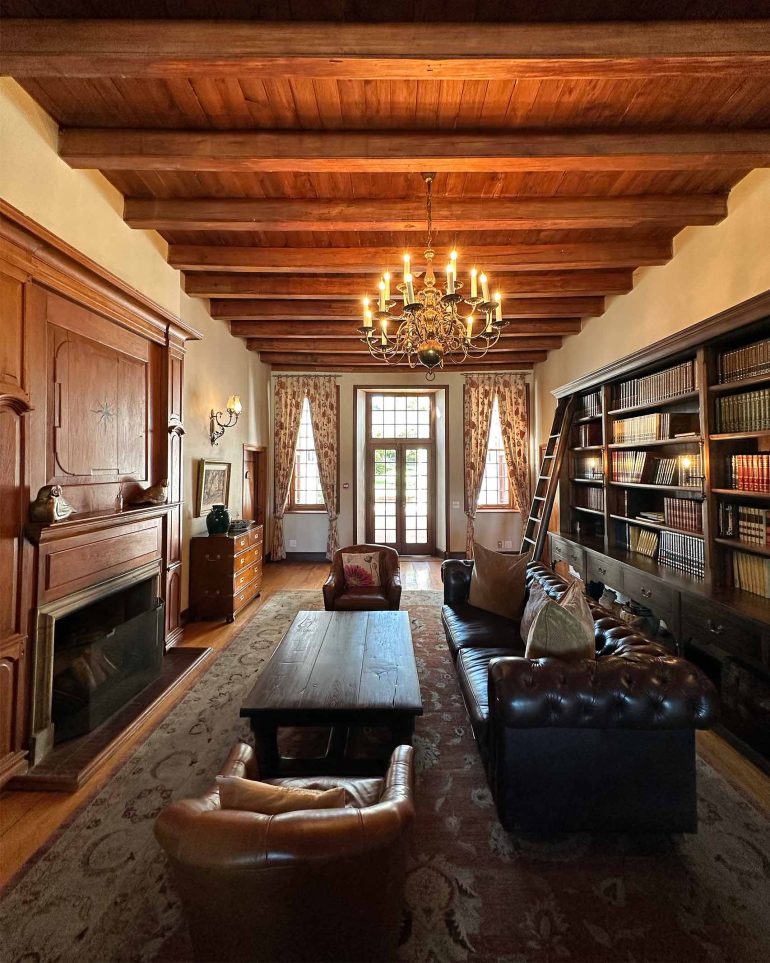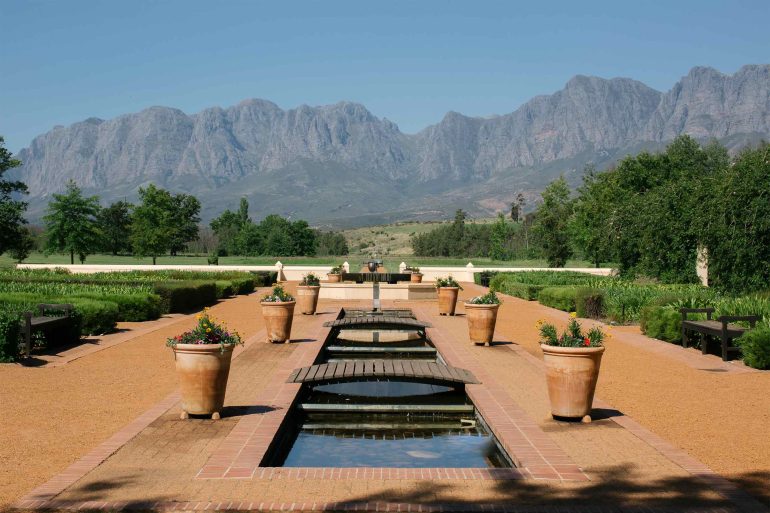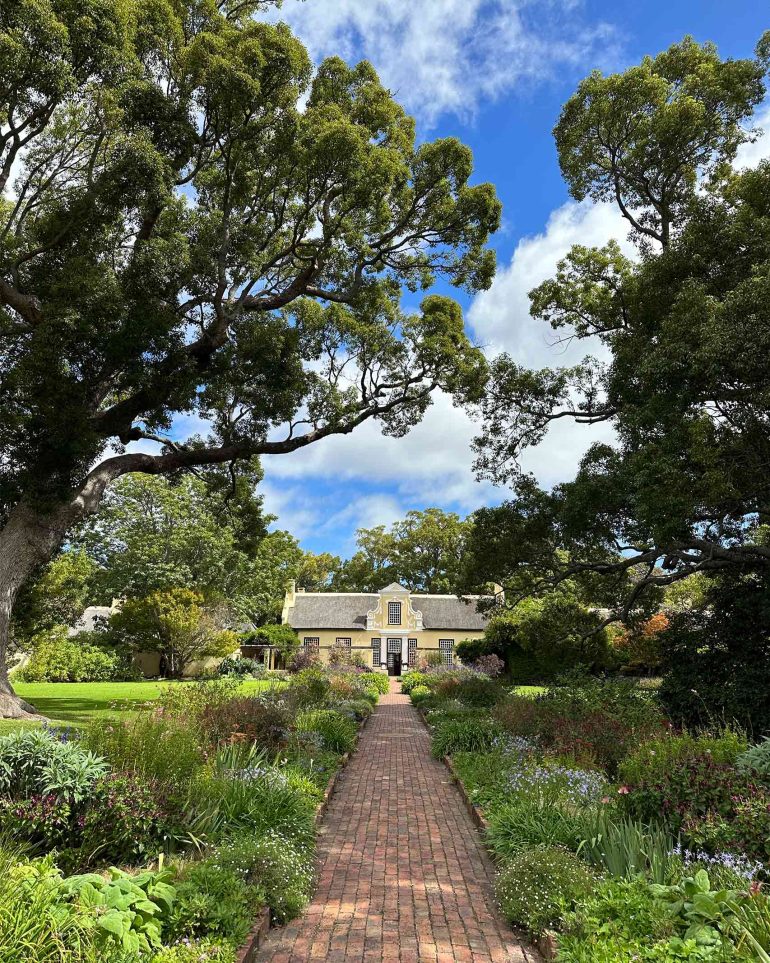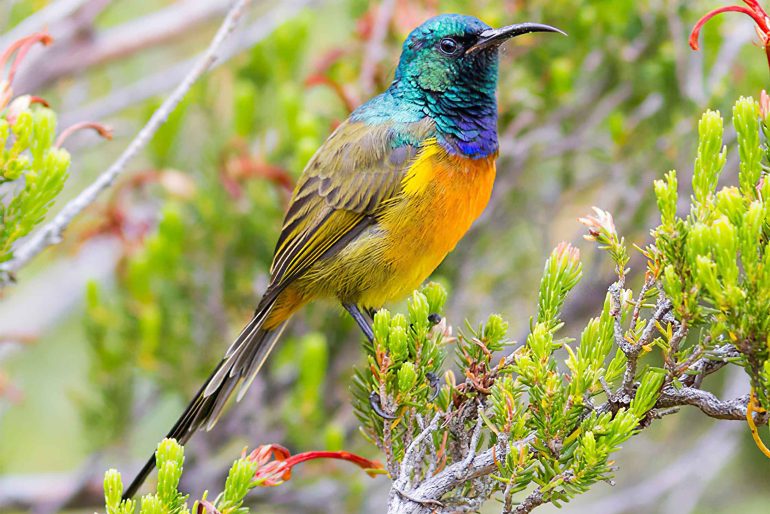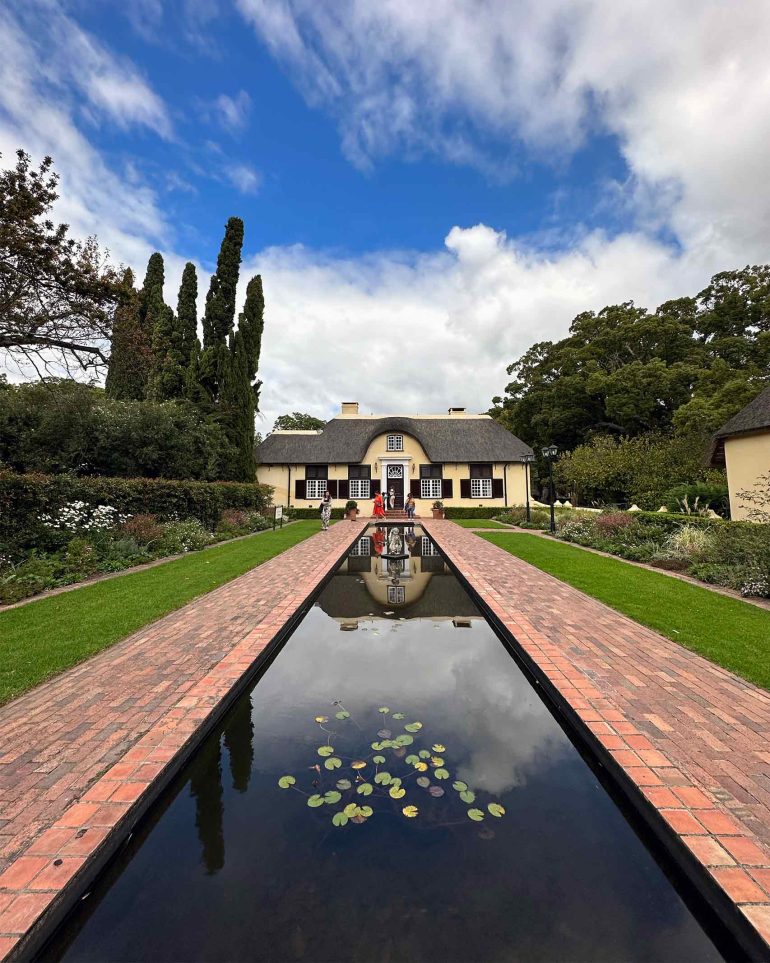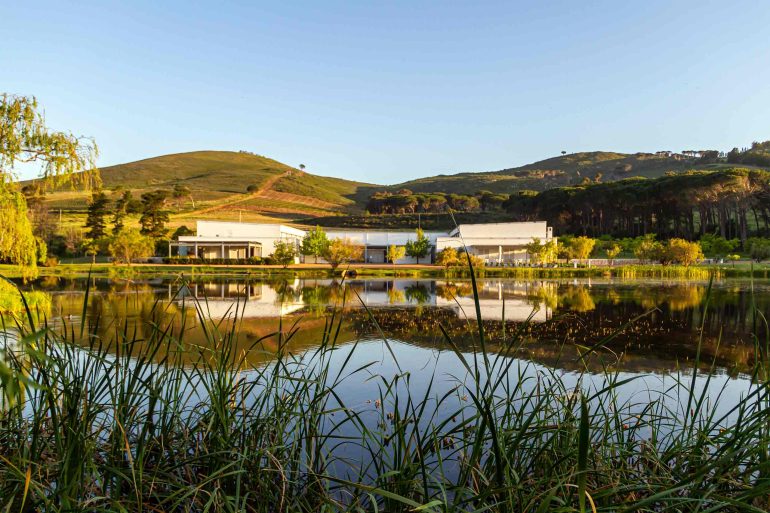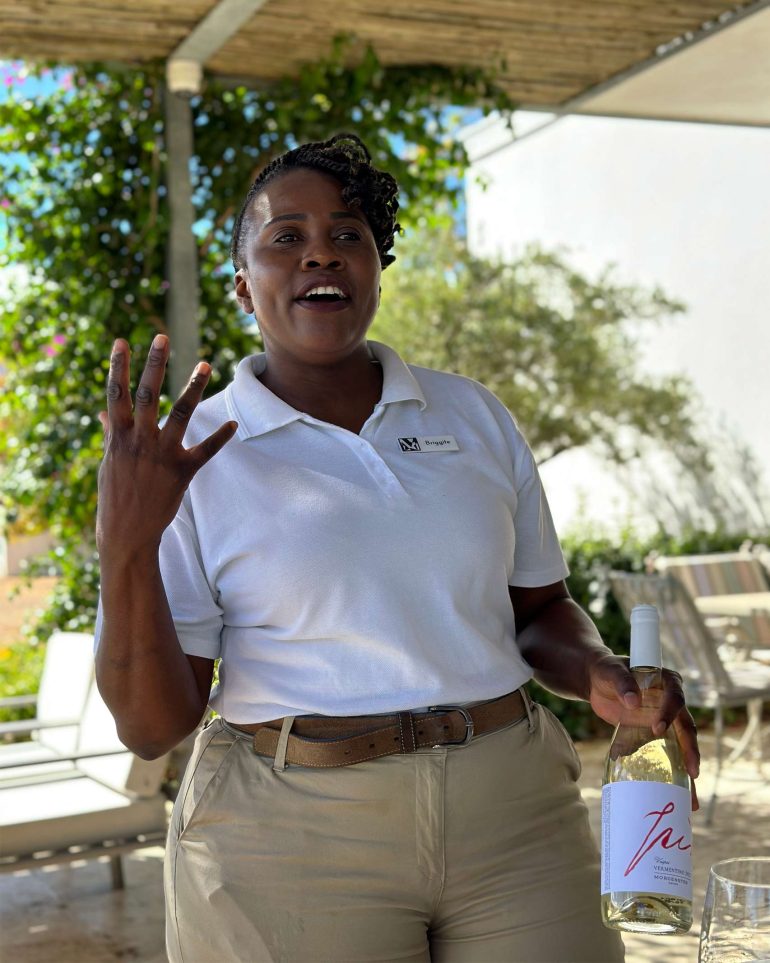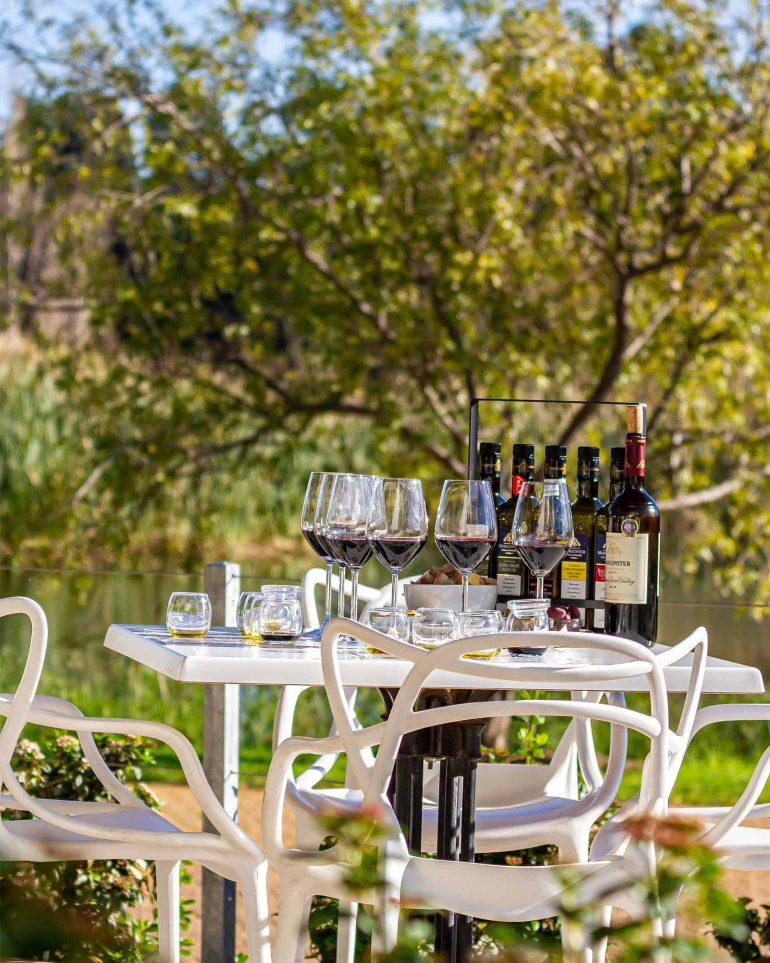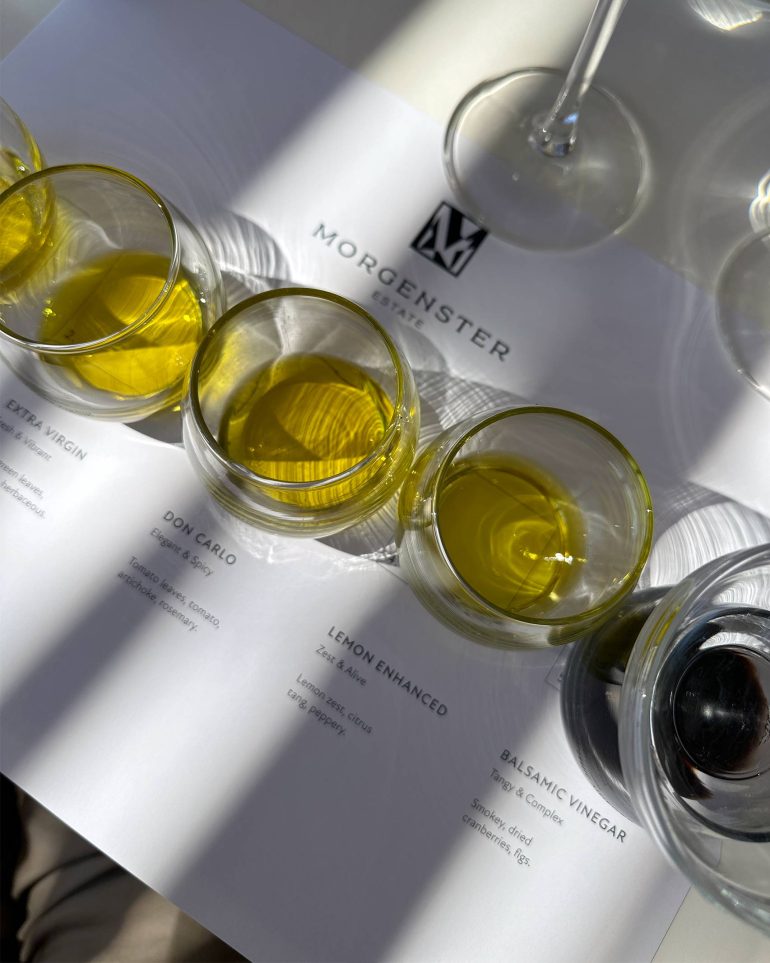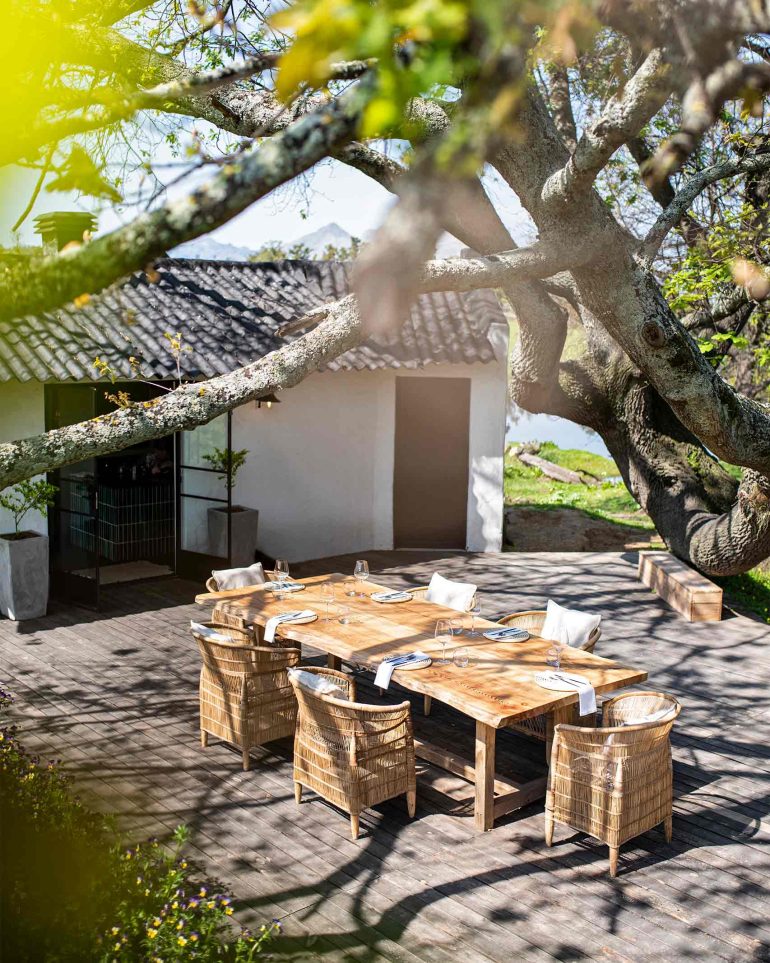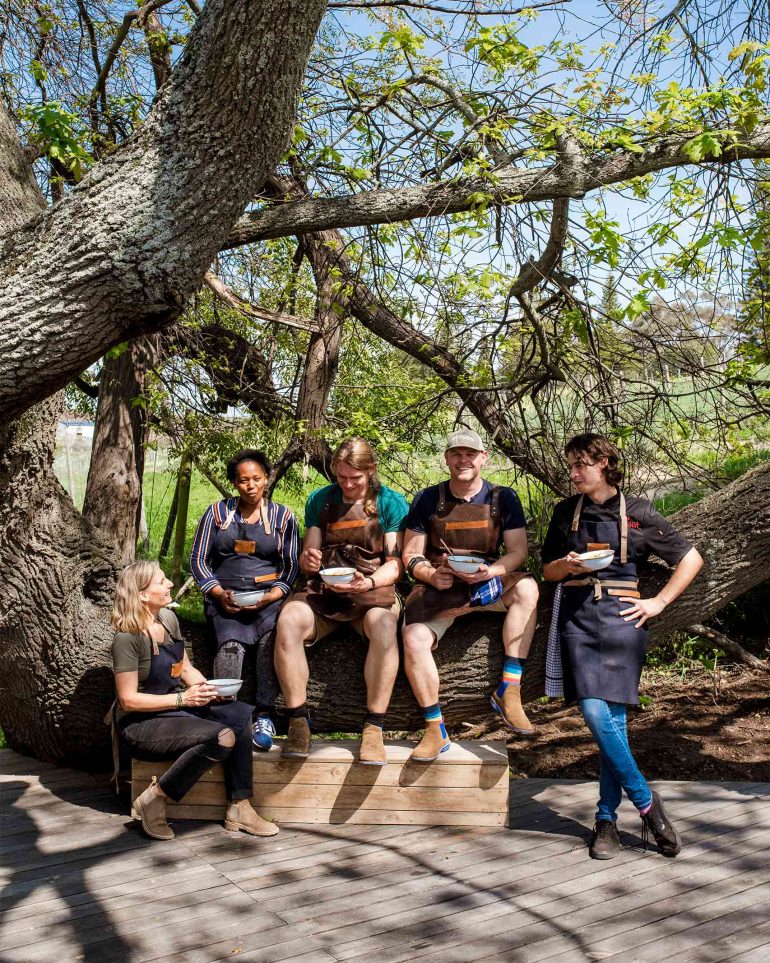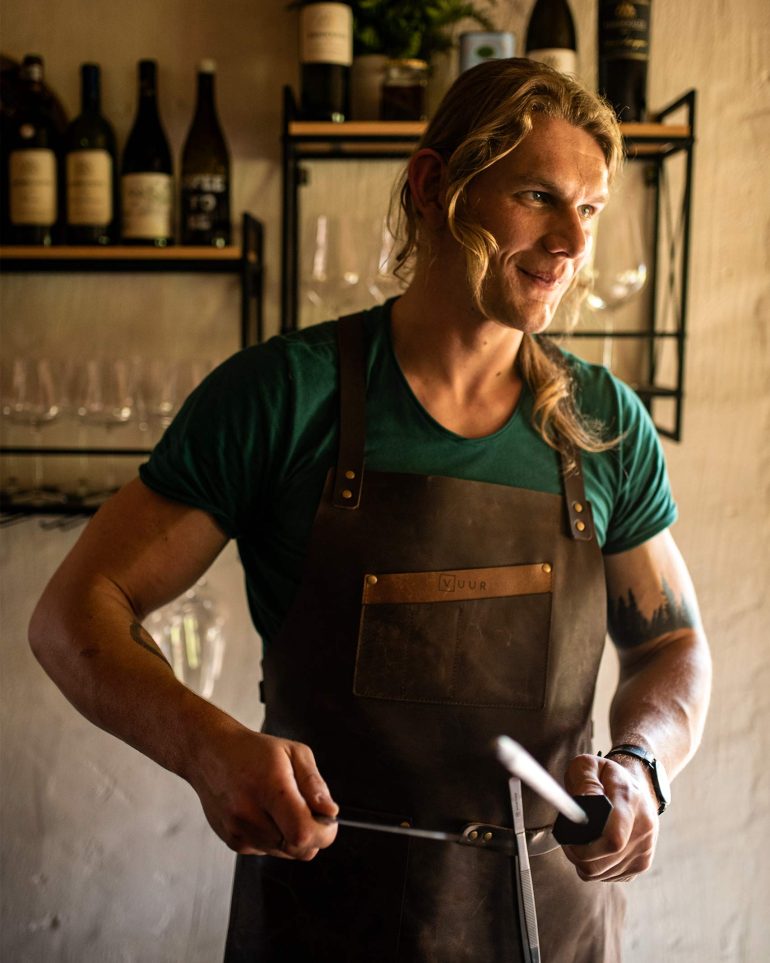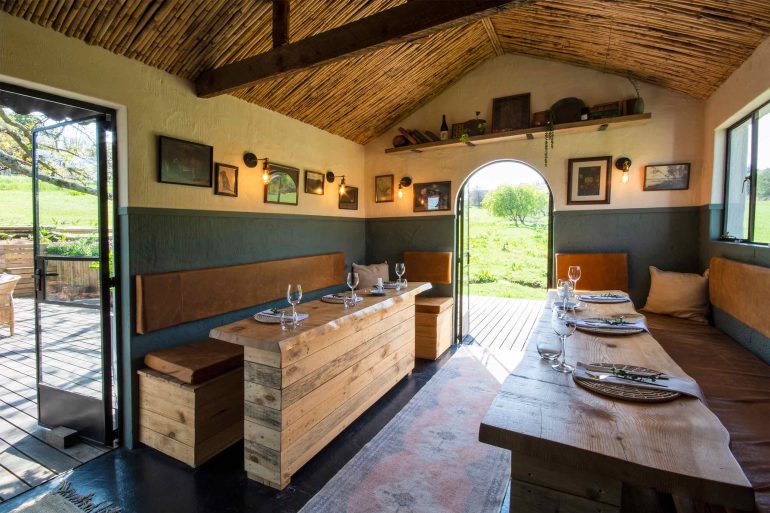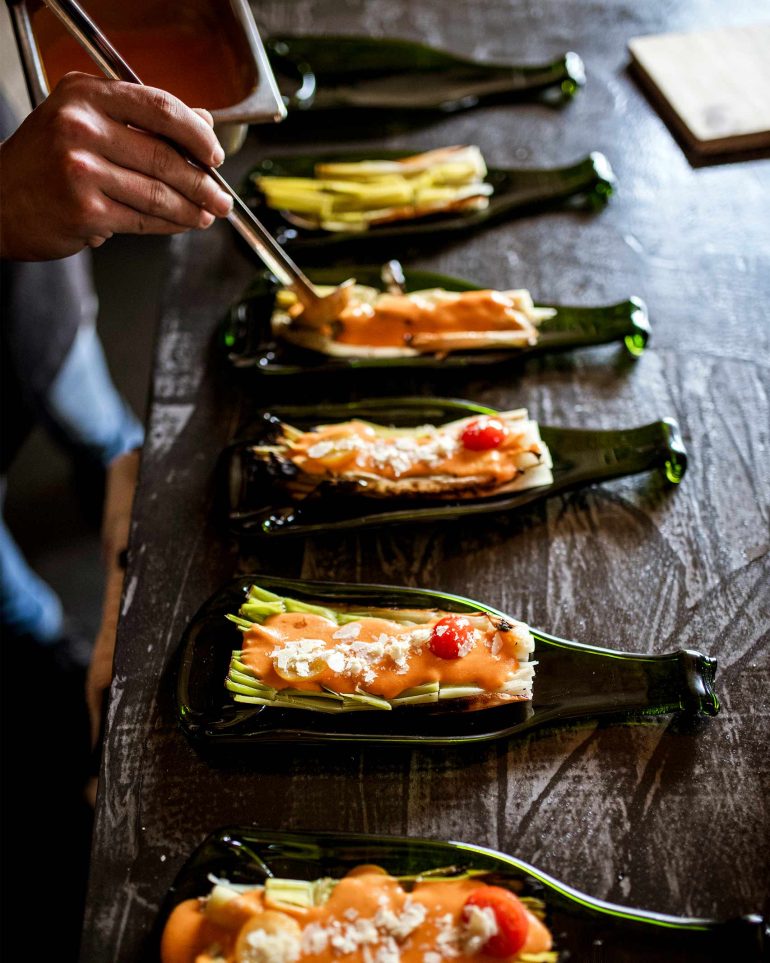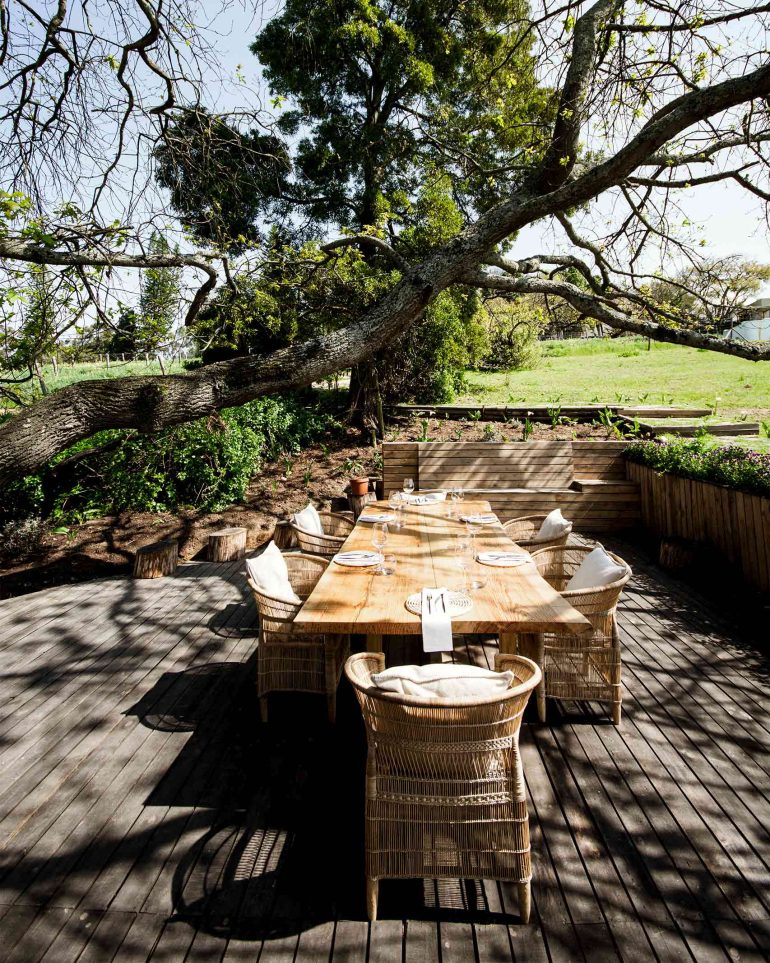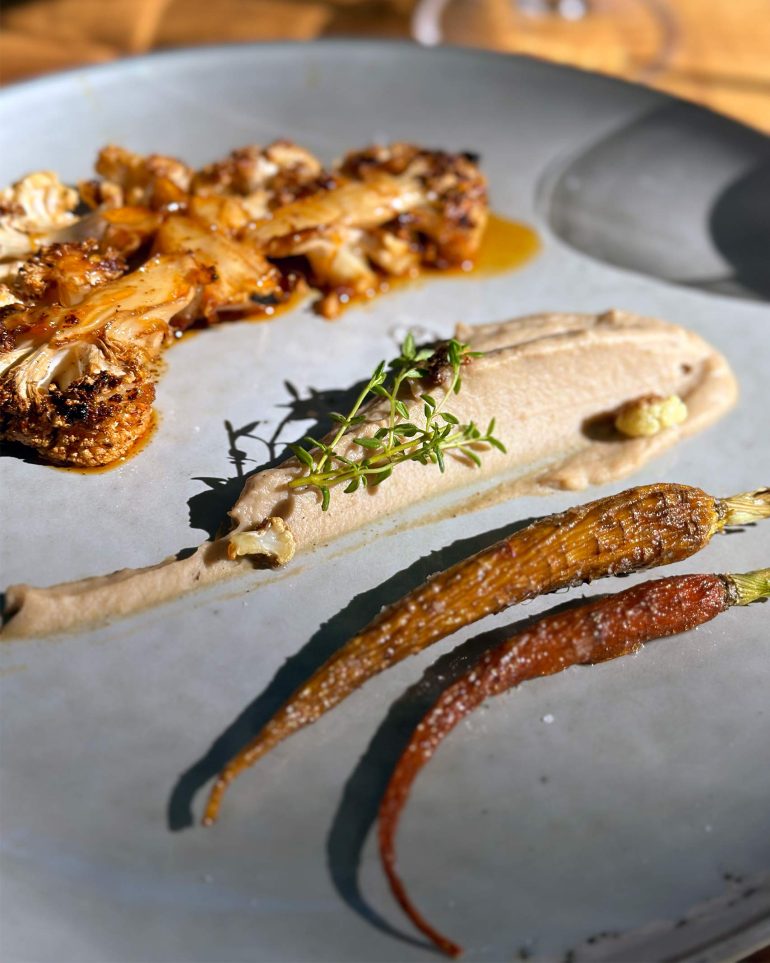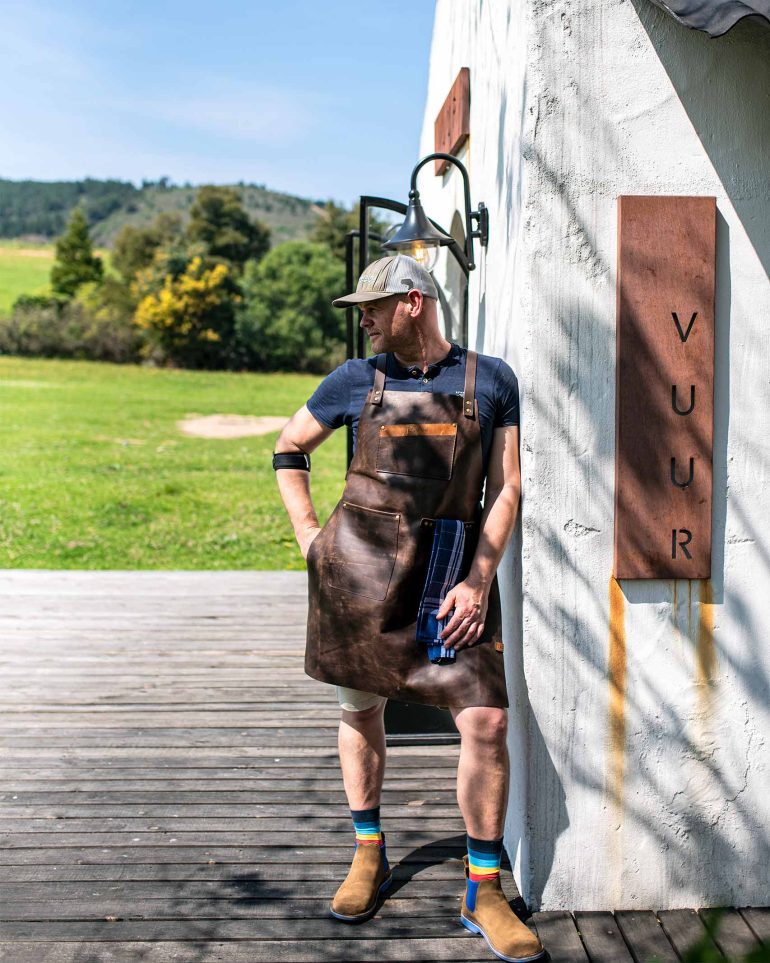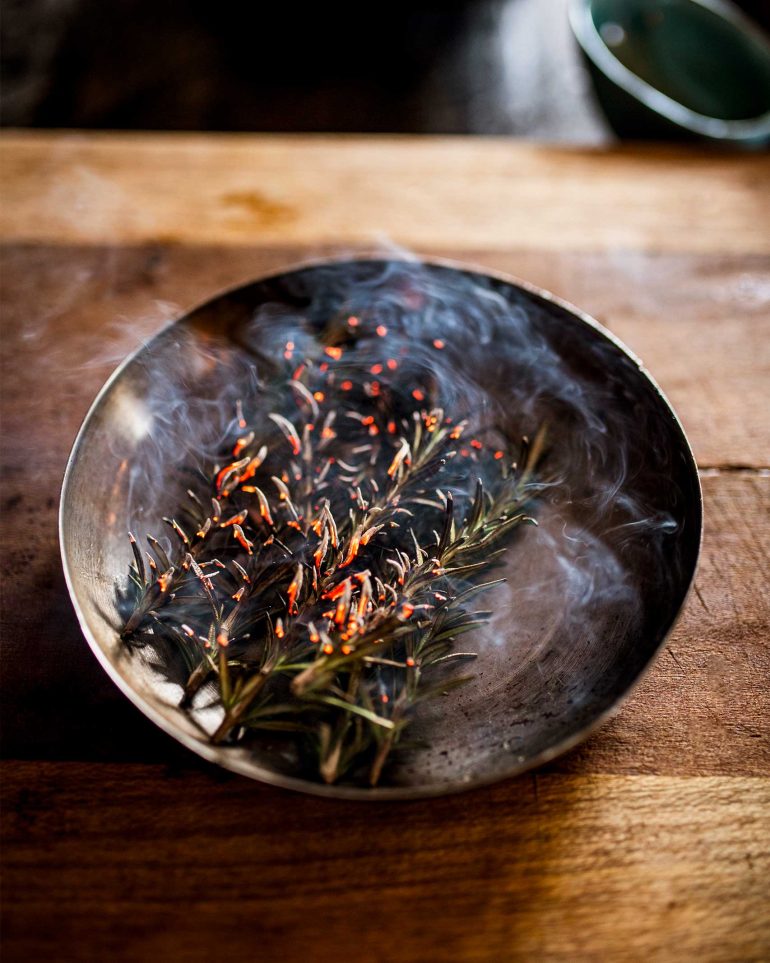On a journey around Cape Town and the surrounding countryside, Steffen Michels gets a taste of all things that have shaped the Western Cape into the evocative destination it is today – from glimpses into South Africa’s past to the spirit of innovation determining the country’s future.
From a vantage point in the sky above Cape Town, the ‘Mother City’ seems an incredibly tranquil place: with each metre in altitude climbed, people – then vehicles, then buildings – slowly shrink to the size of ants, and all the glorious detail that makes them distinctive on the ground blends into a beautiful montage of specks of colour at the foot of Table Mountain. The iconic rock, greenish at the bottom and a greyish shade of brown towards the top, itself doubles as a stage for nature’s original shadow theatre, a spectacle caused by clouds washed across an endless sky high above.
I’m in awe for a second, though my pilot at NAC Helicopters – which has been flying since 1946 from its base in the V&A Waterfront, and even gets some travellers out to safari camps across the Western Cape – assures me that this is only the beginning. I’ve booked a scenic flight over the city and along its coastline. Once we’ve climbed to our desired altitude, our chopper – an insect-like-looking Robinson R44 – gets going: past Signal Hill and all along its ridge, a popular hiking trail that leads to Lion’s Head Mountain. From here, we hover over Camps Bay beach and towards the Twelve Apostles, a mountain range that’s been carved out by the forces of nature to be so dramatic in appearance, you’d be forgiven to think it had been intentionally placed here to ward off an evil spirit submerged in the sea below.
But there’s no sight of anything evil from what I can tell. Instead, the sea is calm today, which is somewhat of a rarity, as the waters off the Cape of Good Hope have been known to be among the world’s most treacherous to sail since Magellan navigated them on the first-ever voyage around the world in the early 16th century. The South Atlantic Ocean and the Indian Ocean meet in this very spot, creating a body of water that’s as deep blue as the former, yet gleams and glimmers in a way I know almost exclusively from the latter. From high above, the scene looks not unlike a million tiny gemstones floating on the surface of the sea before being washed ashore. It’s a perfect precursor for another classic Cape Town experience.
A cut above
Measured in monetary value as well as in carats, South Africa still ranks as the fifth-biggest diamond mining nation. And at Shimanksy, a local jeweller that operates stores here as well as one in NYC, diamonds mean big business. During a popular 1-hour Diamond Experience Tour designed by the brand to give gemstone aficionados a glimpse into all that goes into the production of fine jewellery, I learn about the history of mining and see replicas of some of the world’s most famous diamonds. There’s a lot I didn’t know (unsurprisingly, perhaps, seeing as diamonds aren’t exactly an everyday purchase to me), but aside from the heritage factor or the many shiny stones that are near-hypnotic to admire, what impresses me the most is something else entirely…
It’s seeing the labour that goes into creating these masterpieces that gives me a new appreciation for what’s really a form of art. An important part of the tour, getting to watch Shimansky’s expertly trained diamond cutters work their magic on rough stones (from behind a window, mind you) is fascinating. And it gets better when my guide invites me to step into the manufacturing space, where – dressed in a fully branded diamond polisher uniform – I not only get to look over their shoulder as the team cut away, but even get to try my own hand at refining a 10-carat stone. ‘If I screw it up, do I get to take it home?’ I jokingly ask my guide, who chuckles politely as my mind imagines her giving out a secret signal to alert security while automated bars rise from the ground outside to block all possible exit routes.
Neither of these things happens, of course, and so the final part of the experience, a gin tasting followed by the chance to deck myself in some serious ‘bling’ on the shop floor (talk about a dangerous combination of activities), remains a perfectly scandal-free affair. As I sit there with a Tanzanite around my neck and a diamond on my ring finger, it dawns on me that South Africa is a place that still makes things, and with great mastery and precision, too: while countries like the UK and the USA increasingly export data, shares or NFTs, the economy here remains dependent on the excellence of actual, physical goods to an extent that sees considerable parts of the population employed in everything from manufacturing to expert craftsmanship.
Wine me
What this results in is an unmistakable sense of pride in all that is made here, first and foremost, perhaps, the world-class wines produced in the nearby Cape Winelands. South Africa is best known, as any oenophile can tell you, for its renowned Pinotage, Chenin Blanc and the addictive Méthode Cap Classique, which some prefer even to the finest of champagnes. But due to the large number of vineyards worth paying a visit to, it can be quite the challenge putting together an itinerary that showcases just how diverse the different estates can be. Cue the Heart of the Helderberg, a collection of businesses at the foot of the Helderberg Mountain. Its founding members include the five-starred Erinvale Hotel & Spa along with the nearby, private and state-of-the-art Erinvale Country & Golf Estate, the breathtaking Helderberg Nature Reserve as well as the Lourensford Wine Estate amongst others.
One of the members, Vergelegen Wine Estate, has a history unlike that of any other vineyard in the region. Founded in 1700, the sprawling 3,000-hectare compound features a large variety of gardens, exhibition spaces, restaurants, a wine-tasting centre and more. It also shines a light on South Africa’s colonial past, and crucially, makes no secret that in its early years, Vergelegen itself relied on slave labour. When a dig organised by the University of Cape Town between 1990 and 1992 laid bare the remains of a former slave lodge on the grounds, excavated items were soon after installed and contextualised in Vergelegen’s foyer – at the time, this made the estate one of the first places in the country to feature a dedicated exhibition on the region’s history of slavery.
Walking through the Manor House, which now displays a model of the slave lodge commissioned to further enrich Vergelegen’s exhibition in 2004, I’m moved seeing the exhibits and hearing about ‘Flora’, the name given to an enslaved woman who once lived on the estate, and whose skeletal remains were found during the dig. But I’m also grateful to see that Vergelegen’s modern-day ownership has decided to embrace a remembrance culture that has yet to arrive in some other, formerly-colonised nations, where conflicts of the past are sometimes suppressed or actively glossed over so as to not interfere with the image of a lighthearted holiday destination.
Its exceptional historic importance means that the estate has played host to several significant events, and the list of people who have come here for stately luncheons and gala dinners is impressive, to say the very least: Nelson Mandela has visited several times, while Her Majesty Queen Elizabeth II walked the halls of Vergelegen in 1995. Another Queen, namely Elton John, held a ball with some 500 attendees on the estate to benefit the Elton John AIDS Foundation in 2005. But history alone isn’t what draws people here. As with the other Heart of the Helderberg member vineyards, Vergelegen also produces some of the finest, award-winning wines to come out of South Africa, and no visit here would be complete without a wine tasting.
Mine frankly serves as a bit of a warm-up, as another Heart of the Helderberg member, the more intimate Morgenster Estate, is too close not to stop by. The wines here are fantastic, from a tropical-tasing Sauvignon Blanc to a Reserve White with its sharp and zingy flavours that taste like a crisp summer evening. It’s clear that the team here take immense pride in the vineyard’s offering, though one collection of wines holds a special place in everyone’s hearts: the Giulio Range, named after the estate’s founder Giulio Bertrand, who brought some of Italy’s top grape varietals to South Africa.
It’s not just grapes that Bertrand imported, however. A savvy entrepreneur, he also introduced 17 Italian olive varieties to his estate in 1994, pioneering the production of olive oil in the country, which has since gone from strength to strength – the endeavour later garnered him the local nickname ‘Father of Olive Oil’. Morgenster’s range of extra virgin oils is tempting, and I’m delighted to learn that the estate offers tastings of both its wines as well as its oils. The latter, I find, have a particularly velvety and bold quality that’s no doubt the result of a combination of the Western Cape’s rich soils, its Mediterranean climate and the hand-harvested olives, of which only the finest make it into each bottle (a stand-out is the Don Carlo oil, which is deeply aromatic and leaves a spicy note on the palate).
I don’t quite need convincing to support a place like this, where attention to detail and a pursuit of perfection form the basis of everything the team does. But as with all Heart of the Helderberg members, there’s another reason why travellers might want to visit – the group’s backing of the Imibala Trust, a local non-profit working to provide children that come from impoverished backgrounds with everything they need to thrive in school. The organisation works with a total of 21 schools at the time of writing, and its popular Sponsor-a-Child initiative has proved a valuable tool on the way to a society where opportunities are more widely accessible and no children are left behind. During my time in the Helderberg area, I’m pleased to learn that Imibala also runs a dedicated Creative and Performing Arts Department that exposes children to artistic expression, opening doors for those kids whose talents are within the creative fields.
Dine me
Though I can’t say this surprises me all too much. Creativity is of utmost importance to the people of South Africa. It’d be foolish to attribute this to necessity, however, as is often done when talking about parts of the world where poverty continues to characterise many people’s daily lives. Rather, there’s a lust for innovation in the Western Cape that can perhaps be ascribed to the region’s societal make-up, which isn’t just diverse, but also comparatively young – or young-spirited, anyway (a stroll around the town of Stellenbosch, past trendy yoga studios and organic cafés that wouldn’t look out of place in West Hollywood, is a perfect demonstration of this).
One example of a local eager to try out new things is Shaun Scrooby. When I meet him, he’s clad in his work uniform; a long, heavy apron paired with a baseball hat and some serious forearm protection gear that would make you think he had a job with one of those high-T television channels from the early 2000s, throwing flaming spears from atop a monster truck doing backflips on a Rammstein stage. Upon second glance, however, I notice his comic-style, bright blue and red socks that go some way in showing you can’t pin this man down to a stereotype.
Shaun, like so many Capetonians (as well as those living in the surrounding area), apparently likes to think outside the box. It’s what inspired him to start VUUR Restaurant, which isn’t really a restaurant at all, but a gastronomic experience that can be booked for groups of up to 10 people. The premise is simple: the team, consisting of Shaun, host Tina, assisting chefs Jono and Jack, as well as Bongi, who makes sure everything runs smoothly, cook for a single group each day. There’s one sitting, always at lunchtime, which can variably take place in a rather stylishly transformed stable, or outdoors during the summer months. Between some seven or eight courses, diners also get to try the wines of the adjacent Remhoogte Wine Estate (which, as you’d guess, are excellent).
But a ‘normal meal’, this is by no means, and VUUR’s entire raison d’être is its mission to showcase the imaginative ways ingredients can be refined using an open fire. Everything here has in one way or another been elevated by flames, from leeks to carrots, a smoky Focaccia bread and even the flame-grilled berries I’m served alongside a refreshing sorbet sprinkled with finely cut buchu for dessert. Though the restaurant’s website curiously states that there isn’t a vegan option, my lunch is, after all, made entirely plant-based and perfectly delicious – perhaps, I think, rather than deterring groups of up to 10 people with just one vegan in it, VUUR should be a little more confident about its plant-based offering, and invite everyone to the table.
Cape magic
What matters most here, in any case, is the experiential part of lunch. It’s not every day I descend into a small wildlife camp to eat a meal while zebras, wildebeest, nyalas and springboks graze all around (though, mind you, at a respectful distance). Despite its good accessibility, VUUR feels amazingly hidden away and peaceful. So much, as a matter of fact, that I can’t quite bring myself to leave after lunch, deciding instead to climb a handsome oak tree under which I’d just eaten. Getting up isn’t so hard, not because I’m in particularly good shape, but because the tree has conveniently grown in a way that positively invites you to scale it.
From up here, I look down at the table below and the grassland baking in the sun just across. The shadows of the old oak’s leaves dance on VUUR’s small building and two zebras lie on the hot ground, supposedly not a thing on their minds other than whether to continue lazing away or getting back up to graze some more. This really is a beautiful place. And just like I thought while flying over Cape Town in a helicopter (from a decidedly higher altitude, admittedly), looking at it from a bit of distance makes it even more so. That’s not because the finer details aren’t always the easiest on the eyes – you’ll get that anywhere, from Bali to LA – but because you don’t get the whole picture from up close.
Together, all the things that make the Western Cape the sublime destination that it is, magically add up to an amazingly distinctive travel experience: there’s the local pride in all things made by hand, and all things that come from the soil, from wines renowned the world over to precious gems that sell at record-breaking prices in London and NYC. But there is also a drive for experimentation, a desire to push the envelope and a spirit of optimism of a nation on the cusp of something that is bigger than its tourism industry alone.
South Africa is a place with enough history for two countries. Some of it is tragic, and some of it inspiring. But what I learn during my visit is that all of it informs a stay here in one way or another. The nation’s history is ever-present in the names of its towns, cities and vineyards, but also in its traditional dances and other forms of expression that enrich my time here. Every day, you get a dosage of something beautiful – sea, mountain, craft, gastronomy, the kindness of locals, sand between your toes – and, more often than not, of something utterly original.
Yet I find it never gets old. After an entire month on the Western Cape, looking at it from high above as well as from every other angle imaginable, I’m still only beginning to scratch the surface. One thing I know for sure, however: those who call this place their home know it’s an incredible part of the world. And much to the luck of you and me, they love to share it with others.
On his journey across the Western Cape, Steffen stayed at Cape Town’s The Cellars-Hohenort Hotel (see our review here) as well as at the aforementioned Erinvale Hotel & Spa in Somerset West, historic Lanzerac in Stellenbosch, the whimsical Le Jardin, a private villa rental by Wonderland Escapes, and the Radisson Blu Hotel Waterfront as well as the Radisson RED Hotel back in Cape Town.
Photography by Claire Gunn, Steffen Michels and courtesy of Lanzerac, NAC Helicopters, Shimansky, Heart of the Helderberg, Lourensford Wine Estate, Vergelegen Wine Estate, Morgenster Estate and VUUR Restaurant


